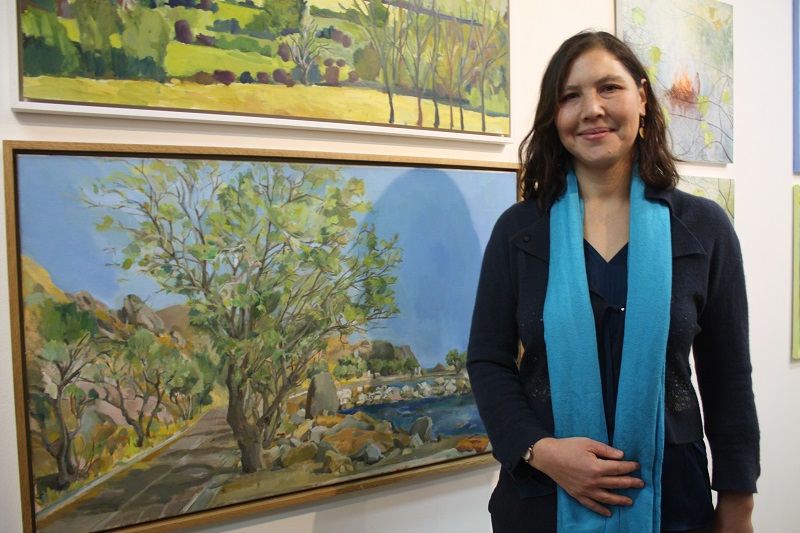
By James Brewer
An idyllic summer scene which is at odds with the distress of the refugee crisis: this is the import of one of the striking paintings in A Sense of Place – Survival, a group exhibition at London’s Bermondsey Project Space which opens a window on what thoughtful contemporary artists are up to.

Natasha Lien painted Refugee Island, Greece, as part of a series based on her frequent visits to Lesbos, an island which she holds dear. Her oil on canvas composition treats of what she calls “this dichotomous subject; that of a place of great beauty and tranquillity which also holds within it recent events of great horror.”
The canvas depicts a landscape without figures; but an abandoned lifejacket hints at the fate of refugees, symbolically questioning what survival entails. Lesbos was a landing stage for thousands of migrants who made the perilous voyage across the eastern Mediterranean Sea since 2015, only to be detained there in squalid conditions before being moved to the Greek mainland or shipped back to their point of departure, Turkey.
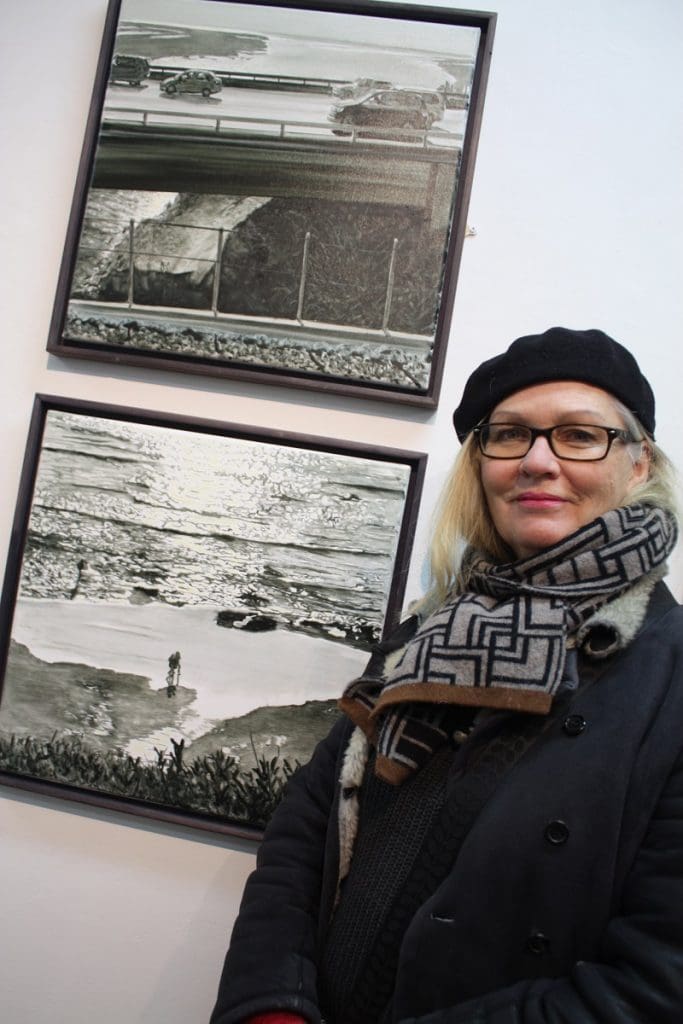
Natasha says that finding a place where we belong is a concern that many people today and all our ancestors have had. In her study of Lesbos, she is “reflecting on the beauty of this place, while acknowledging this trauma,” she writes in the catalogue. The absence of human protagonists in the picture is as though they are drowned from sight. In this sense, it is like a bleak meditation on presence.
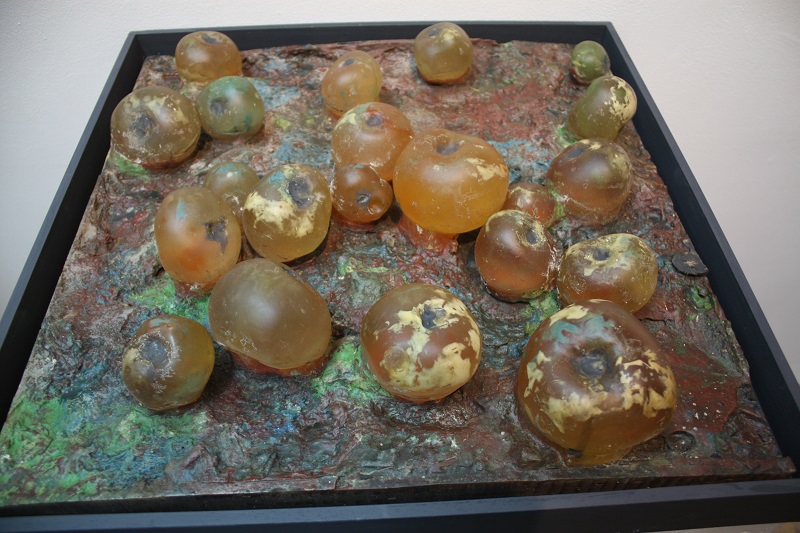
Lesbos suffered great tragedy when fire destroyed the Moria camp, then the largest of its kind in Europe, on September 8, 2020, leaving homeless more than 12,000 men, women, and children. The conflagration was blamed on some camp residents despairing at what they described as hellish conditions.
Natasha says: “I paint from observation but my paintings while observed are not photographic, thus giving an element of mystery to them which enables the viewer to use their imagination.”

She is fascinated by olive tree-blessed Lesbos and its intriguing history, including its status as the birthplace of Sappho, the poet born at Eresos or Mytilene between 630 and 612 BCE whose lyric verses ring with passion and love. She has a statue of Sappho distantly in Refugee Island, Greece.
Natasha is a member of The Arborealists, an ecological art movement founded by the formidably energetic Philippa Beale, who curated the new exhibition in conjunction with Bermondsey Project Space. The show, which apart from a break for the Christmas holidays runs until Saturday January 7, 2023, is the last of three thematically linked exhibitions curated by Philippa responding to the concept of A Sense of Place. It is framed as a challenge to the 30 artists involved to explore deeply how humankind imagines its place on the planet. Quickly it has attracted wide attention: directly after it opened, it scored more than 1,000 hits on Instagram.
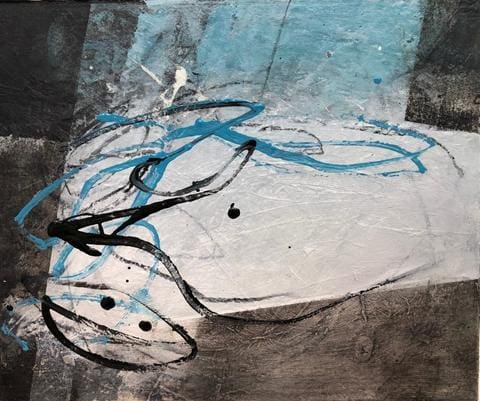
Unbeholden to any rigid approach, the exhibition is informed by the clear concern of each artist about what is happening to our planet and the environment. This takes the form, without taking stances that are aggressive, to their commitment to the aspects of one special place which respectively has a strong identity for each of them.
In her characteristic intriguing abstract style, Day Bowman shows Full Flood 1 – 4, small works on canvas that refer to the tides when in full flood and rock and tide pools brimming over; and there is ‘a parenthesis cut out of the world of flux.’ Day grew up in a small seaside town, and much of her work calls up her memories of the sea, the beach, and the littoral. Visits to south coast resorts have in earlier works impressed on her vision the shapes and lines of decaying constructions on the shoreline, and memories of playing on the sand in her youth.
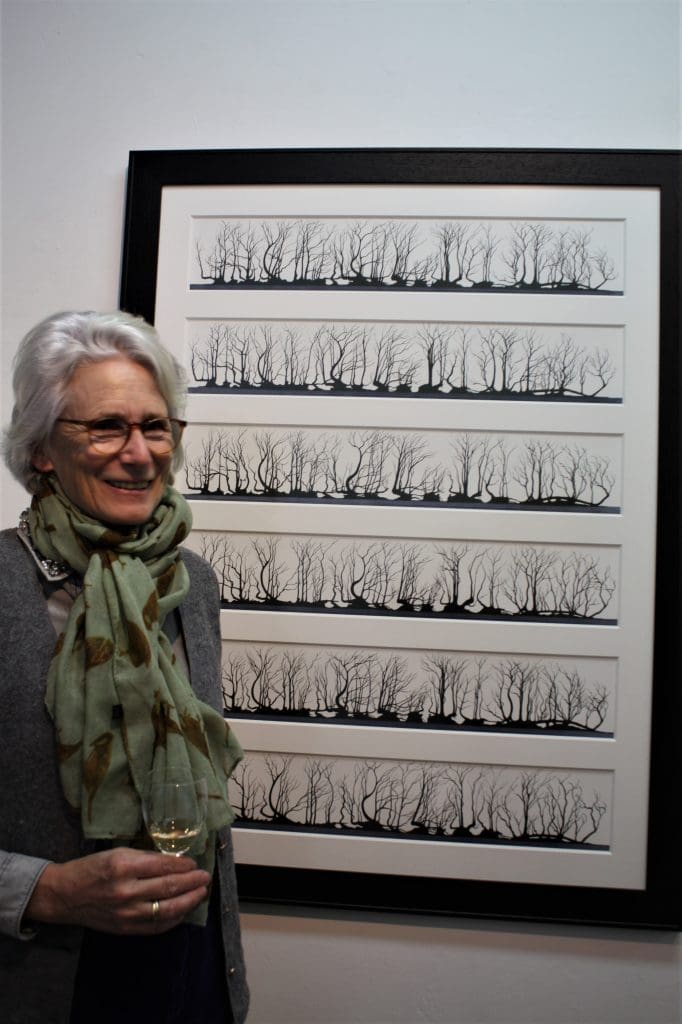
Joanna Hyslop’s ‘place’ is the human skin, resulting here in two oil paintings on sized linen, entitled Dancing Venus III and Dancing Venus IV. She says that place and body, the distant and intimate, coexist in her paintings, and there is an identification between skin and the painted surface of the canvas. Directional marks pulled out of impasto with a stiff brush interact with the play of light and movement, as though it were velvet, and are seen as simultaneously enticing and elusive. “A dance unfolds,” as Joanna puts it.
Some time back Joanna started to use images from her palm in an exercise she deems emphatically personal, yet universal. Using touch and prints from her hands presented significant strands to follow in making paintings. The palette is limited and often tonally close, emphasising the contrasts of surface, dry linen, and paint.

In Windfalls – La tombée du Ciel — Philippa Beale subverts the image shoppers have of apples as sold by retailers – packed neatly in sixes in a harmony of shapes and sizes. She does this by going back to the way apples form a haphazard pattern when they fall from the tree: the reality on the ground, in the true sense of the phrase. The artist gathered two dozen fallen apples and preserved them starting with a plaster of Paris mould on the ground and casting it with resin. This is indeed a slice of reality made from the windfall of fruit.
Phillipa relates how she grew up on a farm with an orchard. “Being under trees was normal for me,” doubtless what has led to her lifelong dedication to celebrating and making artworks related to woodland. She remembers windfalls carefully gathered and made into cider or served as stewed apple and cream; although “as soon as I was able, I escaped to have the pavements beneath my feet, lighted streets and the shops of London, one of the best cities in the world.”
In one canvas comprising six repeated panels, Jo Minoprio with watercolour and stark line depicts an ancient length of beech hedgerow that stands on a worn -out bank “in the middle of nowhere.” This hedge formerly protected four little fields sheltering stock. It is to be found high on Exmoor, surrounded by moorland, exposed to the elements, “forgotten, rendered useless, yet timeless,” says Jo, who lives in the area. “To me it is perfection once laid, evident by the sculptural forms, a thing of beauty, proud and strong. It has been loved so will live forever in the minds of those that truly understand.” Little wonder that she calls her work Where Time Stands Still.

Michele Stagnetto, in her first showing at a London exhibition, entitles her oil painting Gibraltar, “which like certain places is continually threatened by over-development and erosion. A refuge for birds and much more.” She focuses on olive trees surviving on the rock. For Michele, that species evokes resistance, regeneration, and fertility; and she is inspired artistically by its old and twisted forms.
Michele notes that what was once woodland became bare rock through excessive felling and goat grazing over the several sieges of Gibraltar and centuries of change. “Wild olive possibly always existed on the Upper Rock offering food and shelter, a refuge for migrating birds. It might have been the birds themselves which replanted the seeds,” she explains in the catalogue. She says that the Upper Rock, which forms almost 10% of the area of Gibraltar, has remained stable since it became a protected site in 1993. It comes as no surprise that Gibraltar is a favourite place too of curator Philippa.
Marguerite Horner is inspired by, among other places, the coast of California. It was while on a long journey along the seaboard that the word numinous (meaning with a strong religious or spiritual quality and perhaps the presence of a divinity) surged into her mind. Her distinctive monochrome scenes, dominated by lots of horizontals, capture ephemeral moments, otherwise mundane sights into glowing dreamscapes. The art critic Marina Vaizey once said of this winner of the 2018 British Women Artists Award: “Marguerite’s paintings lift the ordinary into the extraordinary, and the specific into the universal…they are about the seen and the unseen, the life behind the eye as well as the world in front of it.”
For the exhibition, Marguerite contributed two of her recent watercolours and two in oil on linen. She also gave a talk entitled Loss and Hope which told of the struggle to sustain hope in the first of the Calais ‘Jungle’ refugee camps.
In a direct manifestation of their concerns about the destruction of forests, the installation Amazon Prime Cut by Lesley and Nigel Slight illustrates the logging threat and spills the sawdust on the floor. The couple quote the National Space Agency as reporting that deforestation of the Amazon rain forest hit a six year high in 2022, with 3,988 km of forest cleared in the first six months of the year. It is said that there are signs of a loss of resilience in more than 75% of the forest.
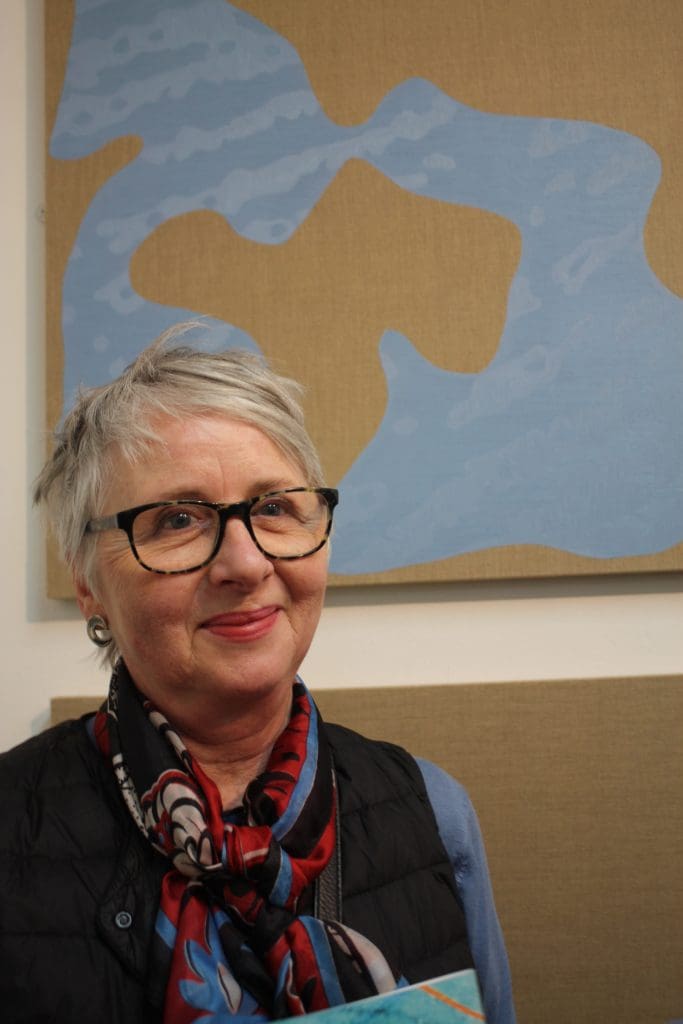
Chris Plato’s 14-minute video illustrates how beautiful a river in France is, but how polluted it is in its struggle for survival. This was an extract from a larger film he has made over seven years.
Sarah Medway deploys bright, bubbling colours for My Fragile Place and My Happy Place, in oil on linen. In her statement about these studies, she wrote: “I spent my formative years on the North Norfolk coast, where my perception was flooded daily by the mysteries and magic of water, wide skies and the perpetually changing symphonies of light, sound and movement in nature.”
Another artist, John Blandy, is devoted to one particular tree: he has spent many years documenting the one outside his house.
Philippa Beale welcomed Jonathan Hunt, father of the National Union of Journalists chapel (office branch) at the Observer, known for his principled newsgathering skills, to declare the exhibition formally open. She thanked the Bermondsey gallery’s director Andrew Etherington and his team for their accomplished organisation and presentation of the works and expressed appreciation to State magazine for its sponsorship.
A Sense of Place – Survival is at Bermondsey Project Space, 183-185 Bermondsey St, London SE1 until January 7, 2023, Tuesday-Saturday 11am – 6pm or by appointment. Closed Friday December 23 until Monday January 2. https://project-space.london





